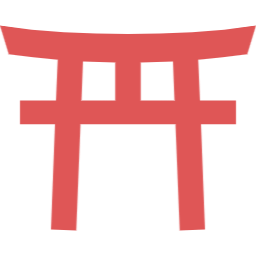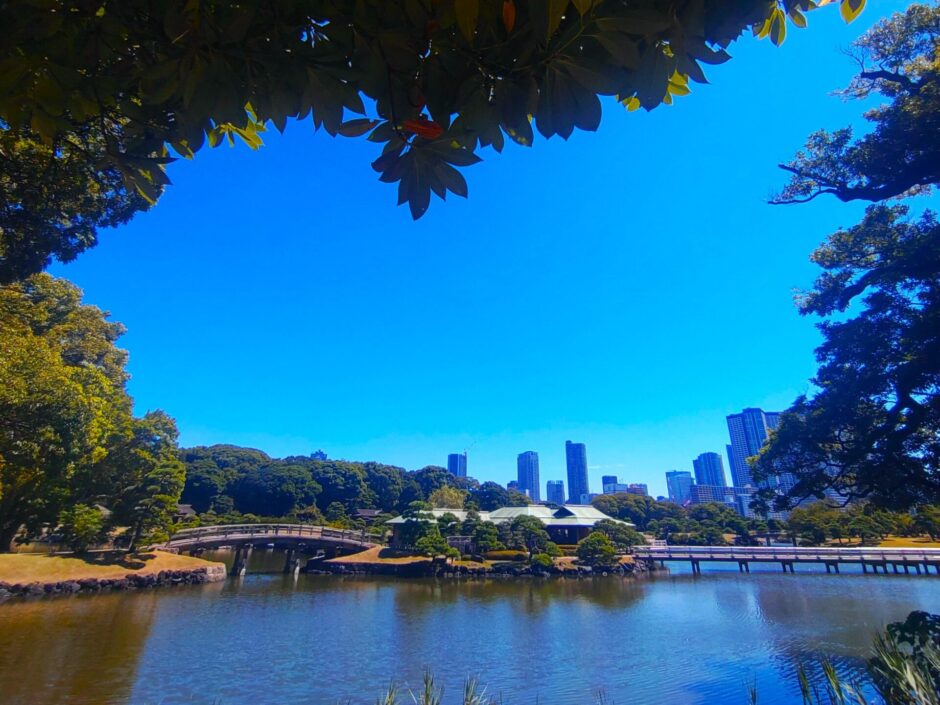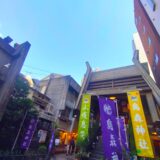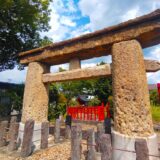目次
- 【Hamarikyu Gardens Summary】
- 【Hamarikyu Gardens Tea House】
- 【Hamarikyu Gardens Tidal Pond and Nakajima Tea House】
- 【Hamarikyu Gardens Duck Pond】
- 【Hamarikyu Gardens Fujimi Mountain】
- 【Hamarikyu Gardens Former Inabu Shrine】
- 【Hamarikyu Gardens Nearby attractions(within a 30-minute walk)】
- 【Hamarikyu Gardens Access】
- Manager’s Comments
- Hamarikyu Gardens
【Hamarikyu Gardens Summary】
Hamarikyu Gardens was originally a falconry ground for the Tokugawa shogunate during the Edo period. Tokugawa Tsunashige is said to have built a villa here. Subsequently, it served as the Hamagoten villa for successive Tokugawa shoguns, undergoing repeated renovations. During the reign of the 11th shogun, Ienari, a tea house was constructed, completing the garden in its present form. After the Meiji Restoration, it became an imperial villa and was renamed “Hamarikyu.” Following damage from the Great Kanto Earthquake and wartime bombings, it was granted to the Tokyo Metropolitan Government in 1945 and opened to the public the following year.
![Hamarikyu Gardens [Tokyo] DSC 2577 1024x768 - Hamarikyu Gardens [Tokyo]](https://japan-shrine.info/wp-content/uploads/DSC_2577-1024x768.jpg)
The current site area is approximately 250,000 square meters, roughly half the size of Tokyo Disneyland.
【Hamarikyu Gardens Tea House】
![Hamarikyu Gardens [Tokyo] DSC 2608 1024x768 - Hamarikyu Gardens [Tokyo]](https://japan-shrine.info/wp-content/uploads/DSC_2608-1024x768.jpg)
Around the Tide-Flooded Pond are the Pine Tea House, the Swallow Tea House, the Hawk Tea House, and the Nakajima Tea House.
![Hamarikyu Gardens [Tokyo] DSC 2593 1024x768 - Hamarikyu Gardens [Tokyo]](https://japan-shrine.info/wp-content/uploads/DSC_2593-1024x768.jpg)
You cannot enter the tatami room, but you can peek inside.
【Hamarikyu Gardens Tidal Pond and Nakajima Tea House】
![Hamarikyu Gardens [Tokyo] DSC 2602 1 1024x768 - Hamarikyu Gardens [Tokyo]](https://japan-shrine.info/wp-content/uploads/DSC_2602-1-1024x768.jpg)
At Nakajima’s Tea House, you can enjoy matcha while taking in the scenery from the tatami room. English is available.
![Hamarikyu Gardens [Tokyo] DSC 2601 1024x768 - Hamarikyu Gardens [Tokyo]](https://japan-shrine.info/wp-content/uploads/DSC_2601-1024x768.jpg)
Tide-in Pond, as its name suggests, is a saltwater pond connected to the sea. Its water flow is regulated by opening and closing floodgates in accordance with Tokyo Bay’s tides. Fish such as mullet, sea bass, goby, and eel enter from Tokyo Bay and appear to thrive here. Currently, this is the only Edo-period garden within Tokyo where seawater is actually drawn in.
【Hamarikyu Gardens Duck Pond】
![Hamarikyu Gardens [Tokyo] DSC 2589 1 1024x768 - Hamarikyu Gardens [Tokyo]](https://japan-shrine.info/wp-content/uploads/DSC_2589-1-1024x768.jpg)
Within the garden grounds lies a facility for capturing ducks for falconry. While commonly found in daimyo gardens during the Edo period, it still retains traces of that era today.
【Hamarikyu Gardens Fujimi Mountain】
![Hamarikyu Gardens [Tokyo] DSC 2605 1 1024x768 - Hamarikyu Gardens [Tokyo]](https://japan-shrine.info/wp-content/uploads/DSC_2605-1-1024x768.jpg)
Climbing the stone steps leads directly to the summit, where you can survey the entire Hamarikyu Gardens—from the tidal pond to the west to the expansive lawns to the east.
![Hamarikyu Gardens [Tokyo] DSC 2606 1024x768 - Hamarikyu Gardens [Tokyo]](https://japan-shrine.info/wp-content/uploads/DSC_2606-1024x768.jpg)
Until the Edo and Meiji periods, as the name suggests, Mount Fuji could be seen from here.
【Hamarikyu Gardens Former Inabu Shrine】
![Hamarikyu Gardens [Tokyo] DSC 2572 1 1024x768 - Hamarikyu Gardens [Tokyo]](https://japan-shrine.info/wp-content/uploads/DSC_2572-1-1024x768.jpg)
Details regarding the founding of the former Inabu Shrine remain unclear, but an Inari shrine has long existed within Hama-rikyu Gardens, which served as a villa for the Tokugawa shogunate. It is a modest wooden shrine building with a tiled roof. It has collapsed due to earthquakes and other causes, undergoing reconstruction and repairs several times; a major repair appears to have been carried out in 2005.
![Hamarikyu Gardens [Tokyo] DSC 2573 1 1024x768 - Hamarikyu Gardens [Tokyo]](https://japan-shrine.info/wp-content/uploads/DSC_2573-1-1024x768.jpg)
It is currently fenced off and, unfortunately, no longer functions as a shrine.
【Hamarikyu Gardens Nearby attractions(within a 30-minute walk)】
Karasumori Shrine, Shiba Daijingu, Namari Shrine, Tsukiji Outer Market, Tsukiji Honganji Temple
【Hamarikyu Gardens Access】
Manager’s Comments
The garden features several highlights, including Edo’s only surviving seawater pond and a tea house that appears to float on the water. The contrast with the surrounding skyscrapers was also spectacular. I think spring or autumn is the best time to visit. The summer heat keeps crowds down, which is a plus.
 Tour of Japanese shrines and temples
Tour of Japanese shrines and temples 

![Hamarikyu Gardens [Tokyo] DSC 2543 520x300 - Hamarikyu Gardens [Tokyo]](https://japan-shrine.info/wp-content/uploads/DSC_2543-520x300.jpg)
![Hamarikyu Gardens [Tokyo] DSC 0592 520x300 - Hamarikyu Gardens [Tokyo]](https://japan-shrine.info/wp-content/uploads/DSC_0592-520x300.jpg)
![Hamarikyu Gardens [Tokyo] c1c75a5c6b72c712994149dec97ff5ef - Hamarikyu Gardens [Tokyo]](https://japan-shrine.info/wp-content/uploads/sng/c1c75a5c6b72c712994149dec97ff5ef.webp)
![Hamarikyu Gardens [Tokyo] DSC 0235 150x150 - Hamarikyu Gardens [Tokyo]](https://japan-shrine.info/wp-content/uploads/DSC_0235-150x150.jpg)
![Hamarikyu Gardens [Tokyo] DSC 1706 1 150x150 - Hamarikyu Gardens [Tokyo]](https://japan-shrine.info/wp-content/uploads/DSC_1706-1-150x150.jpg)
![Hamarikyu Gardens [Tokyo] DSC 1265 150x150 - Hamarikyu Gardens [Tokyo]](https://japan-shrine.info/wp-content/uploads/DSC_1265-150x150.jpg)
![Hamarikyu Gardens [Tokyo] DSC 0348 150x150 - Hamarikyu Gardens [Tokyo]](https://japan-shrine.info/wp-content/uploads/DSC_0348-150x150.jpg)

